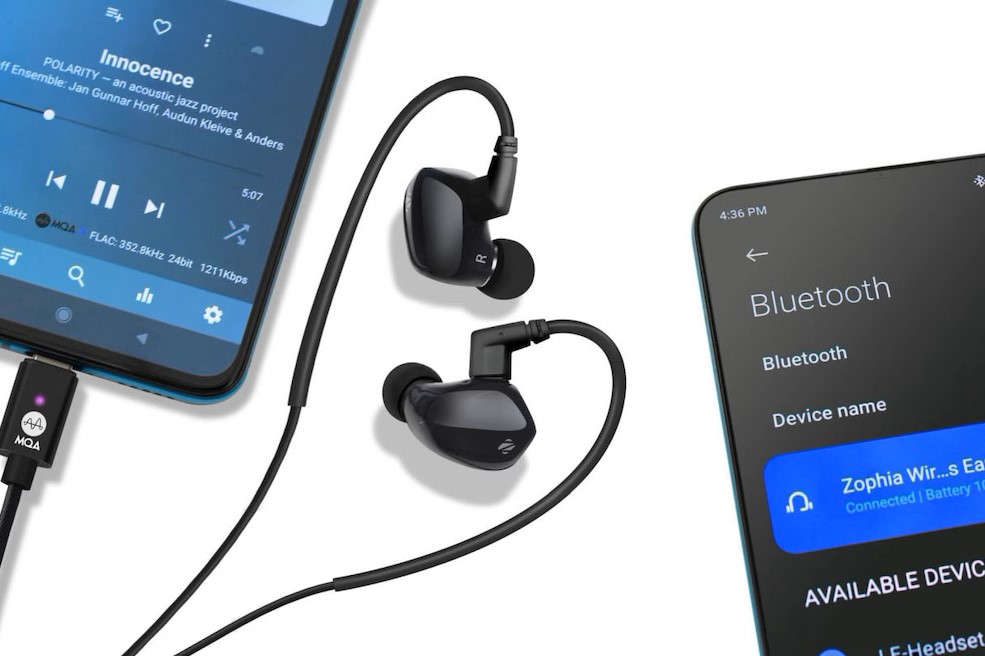Looking for an earphone that provides great audio quality, novel design, and easy setup? Check out our Zophia Wire.less Earphone Review!
Can’t decide between a wired or wireless earphone? Then you should take a look at the new Zophia Wire.less Earphones ($169 for Standard Version, $199 for MQA Version) from Zorloo. Zorloo is primarily known for its great-sounding and affordable USB DACs (which we reviewed here), but now they have brought some of that DAC know-how over into a novel pair of earphones.
I say novel because the Zophia Wire.less Earphones support both wired and wireless operations. It’s the only Hi-Res audio and MQA decoding earphone with wireless features that I know of, and I have to say they implemented these functions in a surprisingly elegant way.
Zophia promises to be a “total solution for HiFi music on the go” and a “perfect companion for music lovers,” but at the end of the day, will it be able to handle both wired and wireless duties without any issues? Check out my review, and I’ll let you know the scoop!
What’s In The Box

- One pair of Zophia wireless earbuds
- One Zophia USB-DAC USB-C Cable (MQA or Standard version)
- Three pairs of ear tips (L/M/S sizes)
- One charging case (feels a little fragile, especially the lid)
- One USB-C charging cable
- One USB-C to USB-A adapter (DAC is plug-and-play for Android, iOS, macOS, and Windows 10/11, so adapters come in handy)
- One Quick Start Guide
- Lightning to USB-C Adapter (Optional)
Zophia Wire.less Earphone Review: Build/Features

It probably appeals to a niche market, but there are some clear upsides to having a pair of True Wireless Earbuds that can also function on the wire. For one, sound quality is usually better when using wired earphones vs. wireless. Secondly, you can take full advantage of Hi-Res audio sources, something you can’t do with Bluetooth.
On the other hand, there’s also a place for wireless operation, like when you’re at the gym and don’t want to get all tangled up in a headphone cable.
That’s where Zorloo’s Zophia comes in. The Zophia earbud has a unique 4-pin plug that allows you to plug in a wire. The 4-pin connection works in conjunction with the supplied USB-DAC/Amp cable, which incorporates technology from Zorloo’s highly-rated Ztella DAC/Amp.
The DAC/Amp cable (MQA Version: ESS Sabre 9281ACPRO Chip/Non-MQA Version: ESS Sabre 9270C Chip) supports sampling frequencies up to PCM 768kHz and DSD 22.5MHz, which is pretty crazy. In addition, the MQA version has an MQA renderer built-in, allowing you to access high-definition audio from Tidal’s Masters Tier.

For an extra 30 bucks, I think the MQA version is worth it, and if you have an iPhone, you can get a package with the lighting adapter included for another ten bucks.
By the way, the portion of the cable that contains the DAC/Amp circuit is contained within a black aluminum sleeve which is amazingly sleek, so you hardly know it’s there. An LED light on top indicates the file type in use (Blue for idle or SD audio <= 48kHz, Red for HD audio > 48kHz, Magenta for MQA content).
Furthermore, the DAC/Headphone cable has a braided jacket that keeps it straight and relatively free of tangles which is a nice thing.
Along with that, I also like how the 4-pin connector has an L-shape, which means it will only fit into the earbuds one way. That makes switching from wireless to wired operation both quick and easy.
Additionally, I dig how the Zophia earbud is backward compatible with the standard 2-pin 0.78mm headphone cable used by many IEMs on the market. That makes it possible to use a standard passive aftermarket cable for even more flexibility.
In terms of Wireless operation, Zophia has a robust connection, as it utilizes the latest Bluetooth v5.2 technology. This gives users a low-latency audio experience, so they can watch videos without lag, play games, etc. Along with that, you can also make calls with the built-in microphone, and thanks to AptX/AAC codec support, you can also get near CD-quality playback.
While I had no major issues, I did notice a couple of quirks when the earbuds auto-switched between wired and wireless operation.
First, while connecting the earbud to the DAC cable, I sometimes turned on paring mode accidentally by tapping the touch control. Then, the earbud’s internal LED light blinked on and on constantly, which was bothersome. I was able to turn it off by pressing the touch control on the bud for 10 seconds or avoid it all together by holding the earbud differently, but that felt somewhat inconvenient.

Second, I noticed a weird hiss in the earbuds after using them in wireless mode, then plugging in the DAC cable. The hiss went away after connecting the cable to my smartphone, but it was disconcerting the first time I heard it.
As far as battery life goes, the earphones have a slightly below-average playing time of five hours, with an additional twenty hours from the charging case. In any case, you should have enough playtime for work commutes or gym workouts.
The Zophia’s 3D printed earpieces have an ergonomic shape that allows them to fit pretty snugly inside your ears. They are on the large side, so if you have smaller ears, that could be an issue, but for me, they were relatively comfortable. The transparent black housing (in a certain light, it looks navy blue) of the earbuds allows you to see the status lights inside, which gives them a futuristic vibe. There’s no active noise canceling, but passive noise canceling is pretty good.
While in wireless mode, you can command playback (play/pause/volume) with a touch on the surface of the earbuds. You can also call up Siri or Google Assistant in order to send voice commands to your phone. The commands are pretty intuitive, but I found the buds slow to react to my touches at times, making me have to repeat touches multiple times.

Inside each earpiece is a 6mm dynamic driver that the manufacturer says is specifically tuned for audiophiles, meaning they are designed for a balanced sound across the frequency range. I really like the tuning of these earphones, but more on that in a minute.
Zophia Wire.less Earphone Review: Sound
For my sound tests, I connected the Zophia to my Samsung Galaxy S21 Ultra 5G phone via Bluetooth (AptX) and via the USB-C port using the included DAC cable. I also tested the included Lightning to USB-C Adapter on my Apple iPhone 14 Pro Max.
On both wired and wireless connections, I got good results playing test tracks via TIDAL, finding a balanced sound signature with plenty of clarity and life. If you’re a fan of boomy/bright V-shaped earphones, then you may not like the Zophia, as it has more of a flat reference tuning.
As far as overall resolution goes, the Zophia was slightly below the top wired IEMs at $200, but it was still really good. It was good to the point that it exposed the flaws of some low-quality recordings.
While listening to Patricia Barber’s “Clique” album, I found the Bass to be deep and articulate with most of the lift in the sub-bass, mids that were sweet and clear albeit a touch recessed, along with a treble that was quite detailed without being too analytical. I guess some may say that the upper mids are a touch too hot if you’re very sensitive to that stuff, but I think they brought some necessary presence to the sound and kept the presentation from sounding too closed in.

As far as Dynamics go, I was truly amazed at the force and weight of the upright bass, along with how the other instruments, like the piano, just jumped out of the clear background. These little plastic buds sounded like full-sized headphones in that regard which was remarkable.
Soundstage and imaging were also really good for an IEM. The stage was nice and wide, going out beyond the ears, and it was plenty deep as well. Focus and separation were slightly below what I’ve heard from other $200 earphones (like the Thieaudio Elixir), but it was close, especially on the wired connection.
As I said before, both the wired and wireless connections sounded great, but the wired connection, with its signal coming through the outboard DAC, had a whole new layer of detail and nuance. The timbre of instruments became a lot more organic, and it was much easier to hear spacial cues in the recording.
Zophia Wire.less Earphone Review: The Wrap Up
Overall, I think the Zorloo Zophia truly is a “total solution for HiFi music on the go,” as long as you’re not looking for Active Noise Canceling. It’s a comfortable set of earbuds with a great balanced sound signature and an easy-to-use wired/wireless cable setup. The switch between wired and wireless modes can be quirky, but for the most part, it works like a charm.
I’ve seen a few wired/wireless products like this on the market, but none with this extensive a feature set or one executed this elegantly. $200 may sound like a lot for wireless earbuds without ANC, but when you consider you’re basically getting three units in one, then the value proposition starts to sound a lot better. That said, If you’re looking for a combination product like this, then you should give the Zophia a try.
Hifitrends is reader-supported. We may earn an affiliate commission when you purchase through links on our site. Prices are subject to change at any time.

I’m an audio writer who started as a young audio salesman/consumer electronics professional back in the late 90s. That’s where I discovered the magic of 2-Channel sound. My hunger for great sound has led me on a delightful music quest that continues today.



Leave a Reply